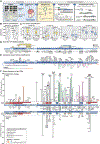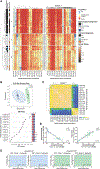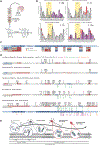Tau PTM Profiles Identify Patient Heterogeneity and Stages of Alzheimer's Disease
- PMID: 33188775
- PMCID: PMC8168922
- DOI: 10.1016/j.cell.2020.10.029
Tau PTM Profiles Identify Patient Heterogeneity and Stages of Alzheimer's Disease
Abstract
To elucidate the role of Tau isoforms and post-translational modification (PTM) stoichiometry in Alzheimer's disease (AD), we generated a high-resolution quantitative proteomics map of 95 PTMs on multiple isoforms of Tau isolated from postmortem human tissue from 49 AD and 42 control subjects. Although Tau PTM maps reveal heterogeneity across subjects, a subset of PTMs display high occupancy and frequency for AD, suggesting importance in disease. Unsupervised analyses indicate that PTMs occur in an ordered manner, leading to Tau aggregation. The processive addition and minimal set of PTMs associated with seeding activity was further defined by analysis of size-fractionated Tau. To summarize, features in the Tau protein critical for disease intervention at different stages of disease are identified, including enrichment of 0N and 4R isoforms, underrepresentation of the C terminus, an increase in negative charge in the proline-rich region (PRR), and a decrease in positive charge in the microtubule binding domain (MBD).
Keywords: FLEXITau; absolute quantification; disease progression; multiple reaction monitoring (MRM); post-translational modifications; prion-like molecules; protein aggregation; proteomics; proteopathy; quantitative mass spectrometry.
Copyright © 2020 Elsevier Inc. All rights reserved.
Conflict of interest statement
Declaration of Interests B.T.H. is a member of the SAB and owns shares in Dewpoint. He also serves on an advisory panel for Biogen, and his laboratory has current research funding from AbbVie. His wife is an employee and shareholder of Novartis.
Figures





References
-
- Arendt T, Stieler JT, and Holzer M. (2016). Tau and tauopathies. Brain Res. Bull. 126, 238–292. - PubMed
Publication types
MeSH terms
Substances
Grants and funding
LinkOut - more resources
Full Text Sources
Other Literature Sources
Medical
Molecular Biology Databases
Miscellaneous

